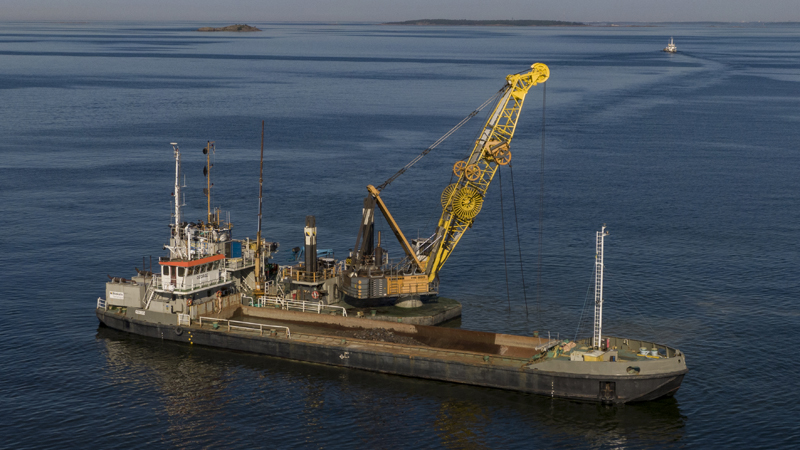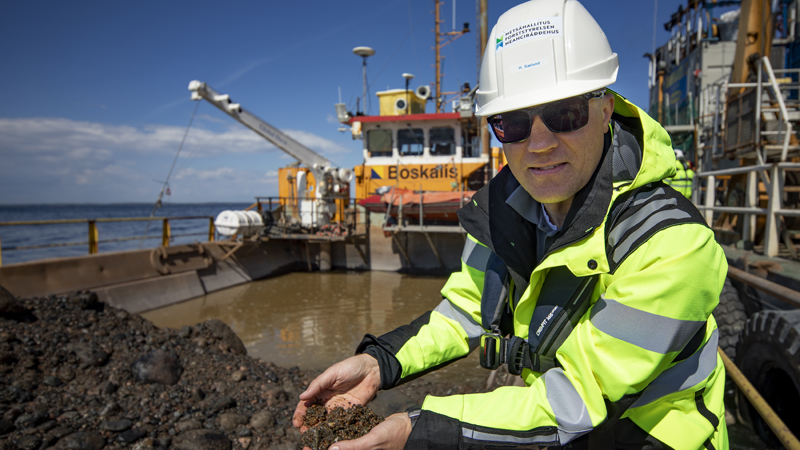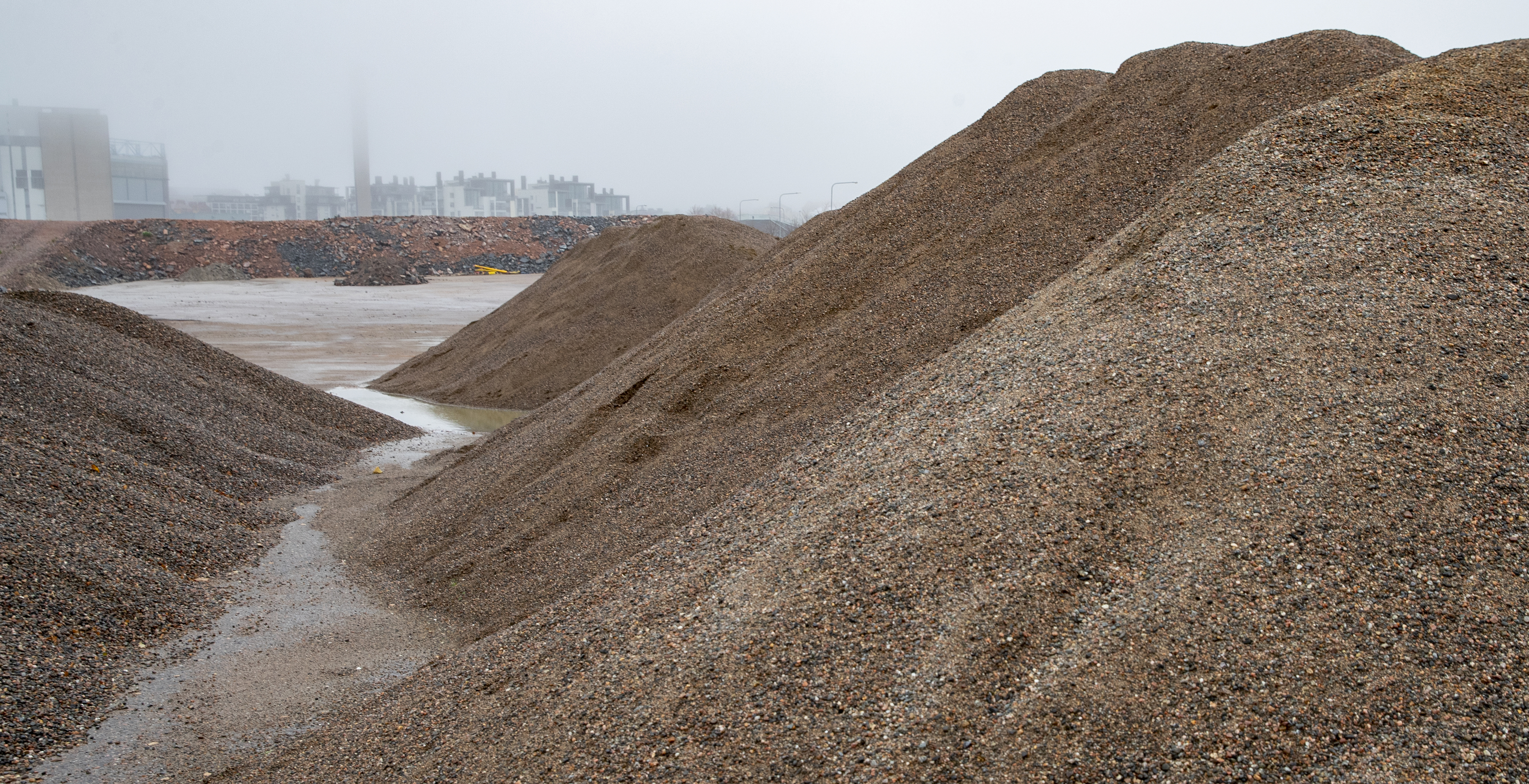Stone aggregates in the seabed
As the availability of terrestrial natural gravel and sand resources decreases, the pressure to exploit seabed aggregates is expected to increase. Moreover, urbanisation and large infrastructure projects, including port expansions and offshore construction projects such as wind farms, also increase the need to make more efficient use of aggregate resources.

Marine aggregates in brief
Marine aggregate is an alternative to gravel from eskers.
The use of marine aggregates reduces the need for and the negative impacts of land transports.
The extraction of marine aggregate is subject to a permit, and the environmental impacts are monitored.
Marine aggregates are well-suited as raw materials for concrete production and for many other purposes.
It is more profitable to extract large quantities of marine aggregate at a time.
Therefore, seabed aggregates can play an important role in the future. They can be used to reduce the pressure of utilising on-shore aggregate resources and to secure the availability of sufficient and high-quality groundwater, while protecting terrestrial ecological values in areas facing extensive operating pressure and human influence.
According to our competitiveness survey, marine aggregates constitute a competitive and sustainable solution as raw material for concrete production, for example. In fact, concrete factories are clearly increasing their share as users of the state’s aggregate reserves in growth centres. Once the gravel ridges around the Helsinki metropolitan area begin to be exhausted, the concrete industry will be shifting to the use of crushed rock. However, the rock material requires further processing.
We are actively studying potential new uses of sea sand. The transition towards a more carbon-neutral society also offers new opportunities for the use of sea sand, such as in energy storage processes. The storing of excess solar and wind power in sand as thermal energy is being studied as one possibility alongside other alternative energy storage solutions.
Marine aggregate reserves
In recent decades, research projects carried out in Finland’s sea areas have mapped out almost all potential sand and gravel reserves connected to the esker formations and Salpausselkä ridge systems running from the mainland to sea areas. Approximately thirty significant aggregate reserves have been found.
To be profitable, the dredging of marine aggregate must be carried out in large quantities at a time. MH-Kivi, a subsidiary of Metsähallitus, has acquired water management permits for the extraction of marine aggregate in the sea areas around Helsinki and Loviisa. The permits entitle the company to extract a total of approximately 25 million tonnes of aggregate.
MH-Kivi does not use the state aggregate reserves it manages on land and at sea but rents them to other companies. Sea sand and gravel will be competitive material choices in upcoming large-scale neighbourhood construction projects, such as Koivusaari in Helsinki and Finnoo in Espoo.
The use of sea sand requires a temporary or permanent support area for the storage and handling of the material, as well as an offloading site near the shore, which should be considered already in the land use planning phase.
Test extraction provided a lot of additional information

In June 2021, MH-Kivi Oy, a subsidiary of Metsähallitus, carried out a test extraction from the Itä-Tonttu reserve in connection with the dredging of the Vuosaari harbour channel. Boskalis Terramare’s grab dredger was used in the test extraction. In more continuous operations, however, the grab dredger will be replaced by a trailing suction hopper dredger for improved profitability.
The extraction of marine aggregates with the suction dredging method is worth the effort if the extracted amounts are approximately 500,000 tonnes at a time. In the ideal scenario, each extraction would take place in the context of a large-scale neighbourhood construction project. For example, around nine million tonnes of marine aggregates were used in the building of Vuosaari Harbour.
According to the results, 70 percent of the aggregates obtained in the test extraction were suitable for concrete production by screening, and the rest could be crushed to suit this purpose. The extracted aggregate materials were also examined in a laboratory. The chloride and humus concentrations in the extracted material were low.

You can learn more about the test extraction in the video. Please note that the video will not be shown unless you have accepted all cookies.
Transport has a significant impact on emissions
The use of marine aggregates significantly reduces the need for land transports, especially in coastal growth centres. When transports are carried out by sea with large vessels and transport distances from ports to concrete factories are shorter than from land-based extraction sites, the carbon dioxide emissions and other impacts of transports are also reduced.
Did you know? One cargo vessel can carry up to 250 truckloads of stone materials.
The emissions are similar for suction dredged sea sand, esker sand, and crushed rock, if the transport distance is 10 km for sea sand, 40 km for esker sand, and 30 km for crushed rock.
Environmental impacts of marine aggregate extraction
During the planning phase of marine aggregate extractions, the seabed fauna, possible effects on birds, turbidity of the water, sea floor vegetation, and the living conditions of fish are carefully examined for the purposes of obtaining a water management permit. The turbidity of the water is regularly monitored during the extraction, and no extraction operations are carried out around islets during the bird nesting season.
In terms of the seabed, the best solution is to suck up the sand and gravel from aboard a moving vessel, but this is rarely possible in the Finnish waters due to the varying shape and rockiness of the seabed. Therefore, suction dredging is carried out from a stationary vessel.
The marine aggregate extraction areas are located in the open sea, and the extraction takes place below the photic zone, which is inhabited by fewer species and the impacts on them are smaller.
Metsähallitus is also studying the possibilities of utilising sea sand and gravel to restore silted seabed for growth areas for the Common Eelgrass (Zostera marina) and for fish spawning areas, for example.
Further information: Utilisation of sea sand and mineral resources in the Finnish sea areas (pdf in Finnish) (julkaisut.valtioneuvosto.fi)
Contact information
Harri Saxlund
Manager, Aggregates and Mining
Puh. +358407199080